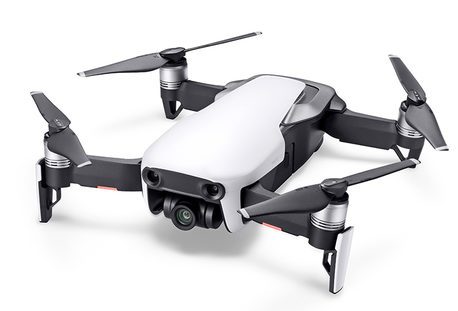There have been plenty of leaks and speculation about what DJI’s big announcement would be today. Now we know. At an event in New York, the drone industry’s leading manufacturer has launched the Mavic Air, a foldable drone targeted towards industry newcomers and photographers keen to cut their gear list down to the essentials. The price: $799.

Here are all of the details…
The Mavic Air: Adventure Unfolds
As DJI’s Michael Perry pulled a Mavic Air out of his pocket, he said that the new drone was his company’s most powerful, portable and intelligent drone to date. It’s important to note that the point is relative to the Mavic Air’s size. Indeed, compared to the rest of the market in this weight division, the Mavic Air looks to be well ahead of the competition.
Weighing in at 430 grams with dimensions of 168x83x49mm while folded, it’s pretty much half the size of a Mavic Pro and weighs 40% less. Which puts it nicely between the Spark and the Mavic Pro in the DJI product lineup. The price has also been carefully considered to help it stand out from DJI’s other drones.
The $399 Spark is very much targeted towards beginners – something reflected in both the price and the onboard camera. The Mavic Air, at $799, offers more in terms of performance and camera quality. There are also a couple of new flight modes, a revamped flight autonomy system and obstacle sensing in 3 directions.
The Camera
One of the Mavic Air’s highlights is a stabilized camera on a 3 axis gimbal. The Mavic Air’s camera houses a 1/2.3” CMOS sensor and the equivalent of a 24mm F2.8 lens. It can take 12mp stills and shoot 4k video. It can also shoot full HD video at 120fps. New HDR algorithms preserve more highlight and low light details.
Small But Safe
Given its size, you might expect DJI to not worry so much about the prospect of the Mavic Air crashing into things. But it would seem as though this drone is the first outing of a new, more advanced flight autonomy system. The Mavic Air can also sense obstacles in 3 directions: to the front, to the back and below.
FlightAutonomy 2.0 processes data gathered from seven onboard cameras and infrared sensors to construct a 3D map of its environment. The result is more precise hovering and better flight performance. The improved forward and backward dual camera vision systems can sense obstacles up to 66 feet (20 meters) away.
But the headline here is the Mavic Air’s Advanced Pilot Assistance Systems, which help the new drone navigate autonomously through complex outdoor environments. With this mode enabled, the drone will sense and bypass obstacles automatically, providing an extra layer of reassurance during flight. That’s a big step forward from simply stopping short of obstacles.
“The day after we started shipping the Mavic Pro we went back to the drawing board to create something entirely new.” – DJI’s Michael Perry
Performance
When it comes to staying in the air, the Mavic Air doesn’t do too badly either. It has a maximum flight time of up to 21 minutes and can handle wind speeds of up to 22 mph (36 kph). According to DJI, it can fly as high as 16,404 ft (5,000 m) above sea level.
The Mavic Air comes with a new remote, which is the first in DJI’s product line to feature detachable control sticks for added portability. Antennas placed on the foldable landing gear help increase signal coverage to deliver a maximum range of up to 2.5 miles (4km), with 1080p real-time video transmission when flying with the remote controller.
In terms of speed, the Mavic Air can hit up to 42 mph when flying in Sport mode. It’s also compatible with DJI Goggles for an immersive FPV flight experience.
For pilots regularly frustrated by a lack of SD cards to hand, the Mavic Air is DJI’s first drone with 8 GB of onboard storage.
New flight modes
As well as supporting multiple panorama modes, the Mavic Air adds to the Rocket, Dronie, Circle and Helix that were introduced with the Spark. These are Asteroid and Boomerang. Asteroid starts with a spherical image that zooms in as it descends toward the subject on the ground, while Boomerang circles the subject in an oval-shaped flight path with the video finishing at the start point.
Friends can't understand how breathtaking your world is? With Boomerang, now they can. #DJI #MavicAir pic.twitter.com/XMoBZC60op
— DJI (@DJIGlobal) January 23, 2018
There are also significant updates to active track. The Mavic Air can detect multiple subjects simultaneously, and higher tracking precision now accommodates for speed changes and irregular movements.
DJI Mavic Air: Price and Availability
The Mavic Air will be available in three colors: Onyx Black, Arctic White and Flame Red. The US retail price including the drone, battery, remote controller, carrying case, two pairs of propeller guards and four pairs of propellers, is $799 USD.
The Mavic Air Fly More Combo includes the drone, three batteries, a remote controller, a travel bag, two pairs of propeller guards, six pairs of propellers, a battery to power bank adapter and battery charging hub, for $999 USD.
Looking back at our prediction
Last week we predicted that the Mavic Air would be weatherproof. Sadly that’s not the case. But still, this looks like an exciting prospect for adventurous photographers. If you thought the Mavic Pro was portable and convenient, the Air looks set to take that to another level.
Malek Murison is a freelance writer and editor with a passion for tech trends and innovation. He handles product reviews, major releases and keeps an eye on the enthusiast market for DroneLife.
Email Malek
Twitter:@malekmurison
Subscribe to DroneLife here.
